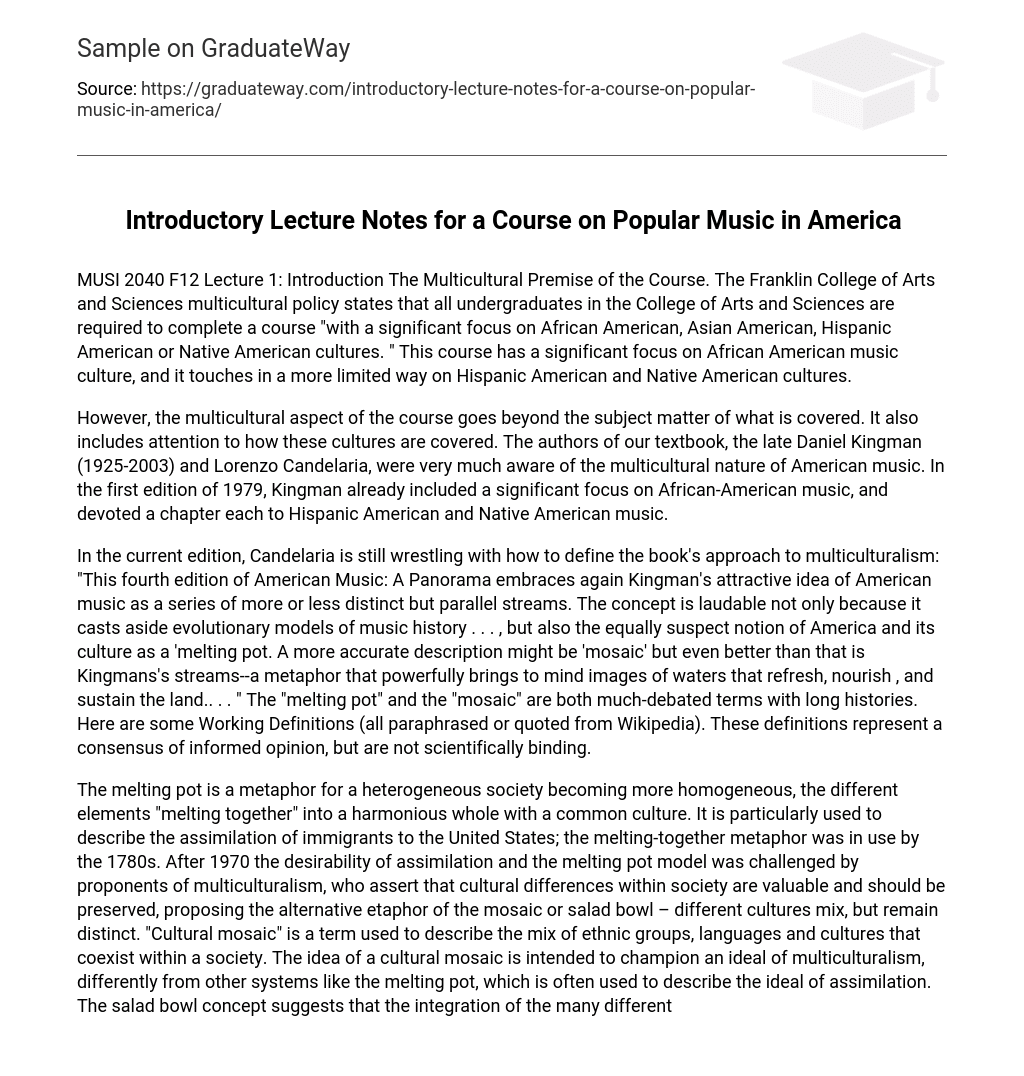MUSI 2040 F12 Lecture 1: Introduction The Multicultural Premise of the Course. The Franklin College of Arts and Sciences multicultural policy states that all undergraduates in the College of Arts and Sciences are required to complete a course “with a significant focus on African American, Asian American, Hispanic American or Native American cultures. ” This course has a significant focus on African American music culture, and it touches in a more limited way on Hispanic American and Native American cultures.
However, the multicultural aspect of the course goes beyond the subject matter of what is covered. It also includes attention to how these cultures are covered. The authors of our textbook, the late Daniel Kingman (1925-2003) and Lorenzo Candelaria, were very much aware of the multicultural nature of American music. In the first edition of 1979, Kingman already included a significant focus on African-American music, and devoted a chapter each to Hispanic American and Native American music.
In the current edition, Candelaria is still wrestling with how to define the book’s approach to multiculturalism: “This fourth edition of American Music: A Panorama embraces again Kingman’s attractive idea of American music as a series of more or less distinct but parallel streams. The concept is laudable not only because it casts aside evolutionary models of music history . . . , but also the equally suspect notion of America and its culture as a ‘melting pot. A more accurate description might be ‘mosaic’ but even better than that is Kingmans’s streams–a metaphor that powerfully brings to mind images of waters that refresh, nourish , and sustain the land.. . . ” The “melting pot” and the “mosaic” are both much-debated terms with long histories. Here are some Working Definitions (all paraphrased or quoted from Wikipedia). These definitions represent a consensus of informed opinion, but are not scientifically binding.
The melting pot is a metaphor for a heterogeneous society becoming more homogeneous, the different elements “melting together” into a harmonious whole with a common culture. It is particularly used to describe the assimilation of immigrants to the United States; the melting-together metaphor was in use by the 1780s. After 1970 the desirability of assimilation and the melting pot model was challenged by proponents of multiculturalism, who assert that cultural differences within society are valuable and should be preserved, proposing the alternative etaphor of the mosaic or salad bowl – different cultures mix, but remain distinct. “Cultural mosaic” is a term used to describe the mix of ethnic groups, languages and cultures that coexist within a society. The idea of a cultural mosaic is intended to champion an ideal of multiculturalism, differently from other systems like the melting pot, which is often used to describe the ideal of assimilation. The salad bowl concept suggests that the integration of the many different cultures of United States residents combine like a salad, as opposed to the more traditional notion of a cultural melting pot.
In the salad bowl model, various American cultures are juxtaposed — like salad ingredients — but do not merge together into a single homogeneous culture; each culture keeps its own distinct qualities. This idea proposes a society of many individual, “pure” cultures. 2. Schiller’s comment: Notice the scare quotes around “pure” in the salad bowl definition. The quote marks mean that the editors know that there is no such thing as a “pure” culture. By the same token, there is no such thing as a “homogeneous” culture.
This means that both the salad bowl and the melting pot are metaphors for processes, not results. The salad bowl metaphor is a metaphor for cultures that are contiguous, tossed together, influencing each other’s flavors, but still distinguishable. The melting pot can be thought of as Fondue Pot, used to combine two or more cheeses whose flavors compliment each other, along with wine to prevent burning and perhaps a little cherry brandy for extra flavor. The study of American popular music reveals that both processes are constantly present in American music.
This makes American music one of the best mediums through which to study American multiculturalism. Virtually every song we study shows some evidence of the “fondue-pot” phenomenon, or the “salad-bowl” phenomenon, or both. As the course unfolds, I will make frequent use of both metaphors. By understanding how these processes of melting and mixing have shaped American music, we can gain a better understanding of how they shape American history and culture more broadly.





